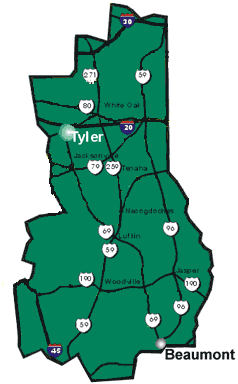 |
|
 |
||||||
Piney Woods
Piney Woods Towns:
Beaver Dam - "Beaver Dam is a small, predominantly black community fourteen miles northwest of DeKalb in northeastern Bowie County. The town, named for a large beaver dam on a nearby creek, has never had a post office. In 1933 it reported one rated business and a population of ten. In the 1940s and 1950s the reported population was twenty-five. In 1984 Beaver Dam comprised a church, a cemetery, and a few scattered houses."
-Bibliography:
J. J. Scheffelin, Bowie County Basic Background Book.
Cuney - "Cuney is at the junction of U.S. Highway 175 and Farm Road 855, twenty-two miles northwest of Rusk in northwestern Cherokee County. The site was first settled by freed slaves just after the Civil War qv and was known for a time as Andy, after Andrew Bragg, a former slave and the first black landowner in the area. A community, however, did not grow up until around 1902, when the settlement became a flag stop on the newly built Texas and New Orleans Railroad. Around 1914 H. L. Price, the cashier at the Farmers and Citizens Savings Bank in Palestine, and several other local investors formed a development company and platted a townsite. They named the town Cuney in honor of Price's son, Cuney Price, who in turn had been named for Norris Wright Cuney, qv a prominent black politician and head of the Republican party qv in Texas. A Cuney post office was authorized in 1917, and by the early 1920s the town had two general stores, a blacksmith shop, several cotton gins, an eleven-grade school, a drugstore, and a hotel. In 1929, when U.S. Highway 175 was paved, most of the town's businesses moved to the highway, a mile north of the railroad. The town's population reached 100 in 1929 but declined during the early 1930s; in 1936 only twenty-five residents and six businesses were reported. Afterward the population grew steadily, from seventy-five in 1952 to 170 in 1990. When Cuney was incorporated in November 1983 it became the first incorporated black community in Cherokee County. A number of businesses closed after World War II, qv but in the late 1980s the town still sustained a post office, two grocery stores, an arts and crafts shop, a beauty shop, a garage, and a sawmill."-Bibliography:
Cherokee County History (Jacksonville, Texas: Cherokee County Historical Commission, 1986).
Hattie Joplin Roach, A History of Cherokee County (Dallas: Southwest, 1934).
Marker Files, Texas Historical Commission, Austin.Easton - "Easton is on Farm Road 2906 ten miles southeast of Longview in extreme southeastern Gregg County and northeastern Rusk County. Most of the site, first known as Walling's Ferry and then as Camden, is near a bluff on the south bank of the Sabine River. In 1885 the Texas, Sabine Valley and Northwestern Railway built a line through the area, and by the late 1880s a large sawmill was in operation there. In 1890 Easton reported the Buchanan and Company general store, a lumber and shingle plant, and a population of seventy-five. The community declined, and most of the remaining white inhabitants moved to Longview or other towns. By 1940 Easton was a predominantly black community with one business and a population of fifty. It revived in the 1940s with the development of oilfields in the area. In March 1949 a post office was again established, after which the town soon incorporated. The incorporated area straddled the Gregg-Rusk county line. Easton had 297 residents in 1970 and 401 in 1990."
"[Major Kennedy] bought whole sections [of Texas land] at a time since land was inexpensive. By 1930, when the East Texas oil boom hit, he had acquired substantial land and livestock. The oil discovered on his land brought him greater wealth, and he joined with other East Texas blacks to form the Tiger Oil and Gas Company. Kennedy became a leader among African Americans because of his financial power and built the all-black town of Easton, on the border of Gregg and Rusk counties. He owned a mercantile store, a garment factory, a sawmill, a number of rent houses, and most of the land in the town by the time of his death. He supported the Pirtle Baptist Church in Easton and donated land for its cemetery.
He also made generous contributions to Butler College, the Progressive Voters' League, the YMCA, and various civil rights causes. He also constructed churches and schools in East Texas, financed the studies of a number of students, and donated fifty acres of land to the Boy Scouts of America for Camp Kennedy, which included a lake with swimming and fishing facilities. He and Mary had ten children. Kennedy died on July 12, 1952."-Bibliography:
Effie Kaye Adams, Tall Black Texans: Men of Courage (Dubuque, Iowa: Kendall-Hunt, 1972).
Houston Chronicle Magazine, July 13, 1952.Sources:
"BEAVER DAM, TX." The Handbook of Texas Online. [Accessed Fri Jul 4 6:45:15 US/Central 2003 ]. by Cecil Harper, Jr.
"CUNEY, TX." The Handbook of Texas Online. [Accessed Fri Jul 4 US/Central 2003 ]. by Christopher Long
"Major Kennedy" The Handbook of Texas Online. [Accessed Fri Jul 4 6:15:15 US/Central 2003 ]. by Nolan Thompson
"EASTON, TX." The Handbook of Texas Online. [Accessed Fri Jul 4 6:18:01 US/Central 2003 ]. by Norman W. Black
![]()
